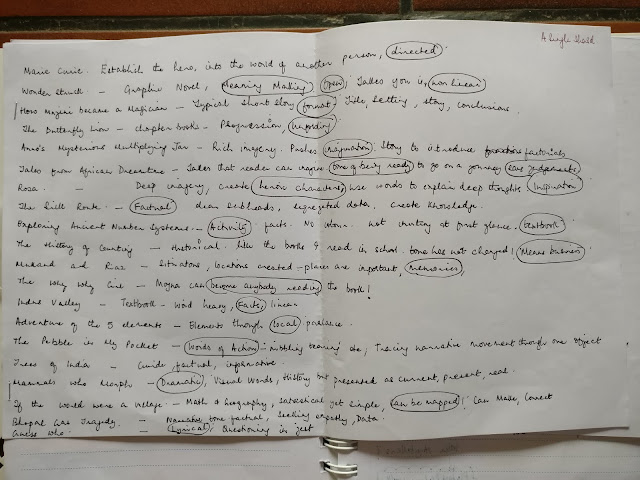Setting Beginnings - Stories & Cognition
Day 1
How did I pick a story? Did I Know Or Think?
The 20 books that I picked were a mix of fiction, non-fiction, some were textbooks ‘masquerading’ as picture books. I gravitated toward my selection books naturally and did not make a huge effort to choose. It was the titles that first spoke to me. But I wonder now if I was placing a certain expectation from them based on this (Thinking?). Did I sort of 'know' what to expect from each of the books? Was my selection based on a certain expectation based on prior knowledge of what something should mean when it looks a certain way? How had expectation become embodied in this form?
However, when I began reading the book there were 2 books which completely surprised me. Anno’s Mysterious Multiplying Jar, I had imagined was a historical tale, but it turned out to be a story of factorials! Mukund and Riaz, the story started out as a simple tale of friendship but turned out to be about the partition of India.
What struck me about both these books is how seamlessly the story was told with no fanfare, just taking the reader along. At certain points, I was thinking to understand where this story was leading and trying to make conclusive connections. Anno’s Mysterious Jar was an absolute surprise in this case. In Mukund and Riaz there were parts where I thought why there were British soldiers in the story even when it sounded so current, I even tried placing it within a timeframe. There was a tingling sensation all along that I knew something more, deeper and there was more ‘within’ me about this story. I continued to read and let the story reveal itself. And when the partition frame was unlocked, I went Hah! both in surprise, and recollection of what I already know about the partition.
Mapping the Books I Read
It was quite surprising that when I was noting down details of the books I described the books using adjectives like - lyrical, dramatic, factual, etc. I was surprised to see that narratives naturally fall under certain categories. I am compelled to believe then that it is the style of narrative the narrative that creates thinking or knowing.
I then went on to plot the narratives styles of two categories of books - Nonfiction & Textbooks. As I did this, I figured that narratives of a certain form call for specific components like style, format, imagery, etc. These components add greatly to creating impactful Thinking or Knowing spaces.
Soon after these activities, I depicted Thinking vs. Knowing like in the picture below. I am curious to see if this will move by the end of this semester.
Day 2 - Storyboarding
I had picked one of my all time favourite stories The Library Lion to storyboard. This delightful story is about a Lion who loves books and comes to become a part of a local library. Through a series of unpredictable events a poignant tale of love for books, care and bending rules once in a while are explored. I was curious to see how I can break a book which is high on emotions into smaller frames without losing its plot or essence, and yet render the story effectively. Interestingly, I am able to envision doing this for many more stories with very complex plots too! I currently believe that every story can be told at a skeletal level, but it is the rasas, literary devices and the metaphors (visual and verbal) that build it into an 'effective story' that engages the reader in both Thinking and Knowing.
The Library Lion
Day 3 - Books I want to write
I came up with 20 titles of books I would like to write and I am very happy to have been allowed the freedom to think like an author for once :). Some of the titles are cringe worthy though. I feel that I gave too much time to planning the story in some cases and didn’t just write the titles with abandon.







Comments
Post a Comment